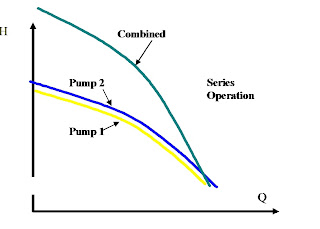MARINESHELF publishes articles contributed by seafarers and other marine related sites solely for the benefit of seafarers .All copyright materials are owned by its respective authors or publishers.
Performance
Curves
Head ~ Flow H~Q
The static Head
is the difference between suction head and delivered head. As the suction Head
changes then the Static Head changes.
When the pump is operating the liquid will be moving
within the pipework and so a loss due to friction will occur
Dynamic Head H =
HD - HS - HF
Positive displacement.
A positive displacement pump encloses
a volume of fluid and physically displaces it to the pump discharge. The flow
of the pump is therefore constant depending on the speed.
A reduction in flow will occur as the
head increases due to internal leakage. This slip is greater for rotary
pumps than reciprocating pumps.
Centrifugal.
For a centrifugal pump, which uses the
conservation of energy principle, which changes velocity energy into pressure
energy, as the flow rate, Q, decreases then the differential pressure head, H,
increases.
This would curve a performance curve
of
Operating centrifugal
pumps in series means that the pressure head of the second pump adds
to the pressure head of the first. Due to system and pump losses the total head
will be less than the sum of the individual heads. The flow rate through
the second pump can only equal tOperating centrifugal pumps in parallel
means that the flow of the second pump adds to the flow of the
first. Due to system and pump losses the total flow will be less than the sum
of the individual flows. The pressure head of both pumps can only equal
that of the lower value.
that of the first pump
Power requirements are at a minimum
when the flow is zero.
Efficiency = Useful work out / work supplied.
This is at a maximum when the losses are at a minimum







3 comments:
Top post. I look forward to reading more. Cheers
This is an amazing post. Thanks for sharing.
dry vacuum pump
roots vacuum pump
rotary vane pump
Are you looking for reliable pumping solutions? Jee Pumps offers
Centrifugal Pump,
Diaphragm Pump,
Vertical Turbine Pump, and
Boiler Feed Pump
that are strong, efficient, and perfect for different industrial uses.
Contact us today to get the best pump for your needs!
Post a Comment